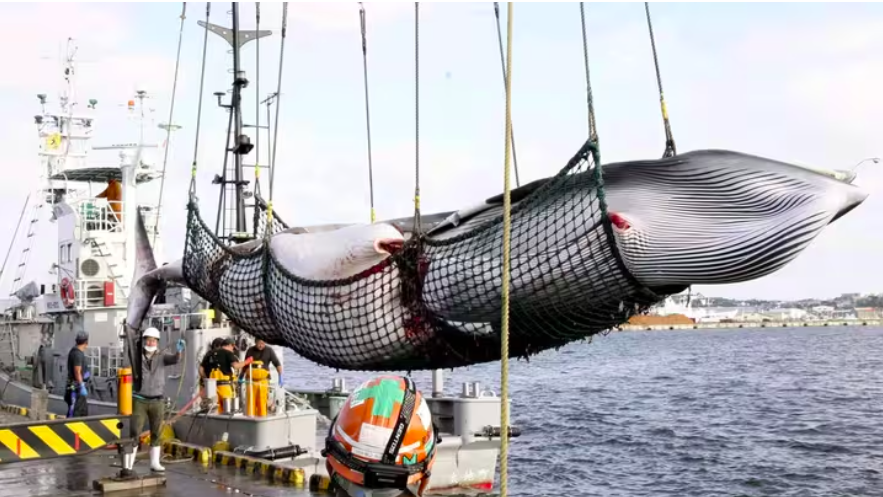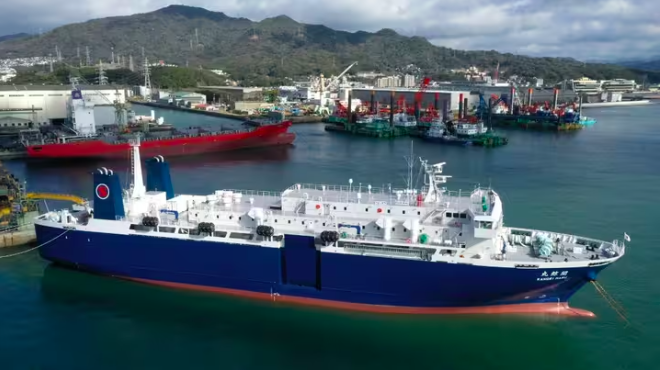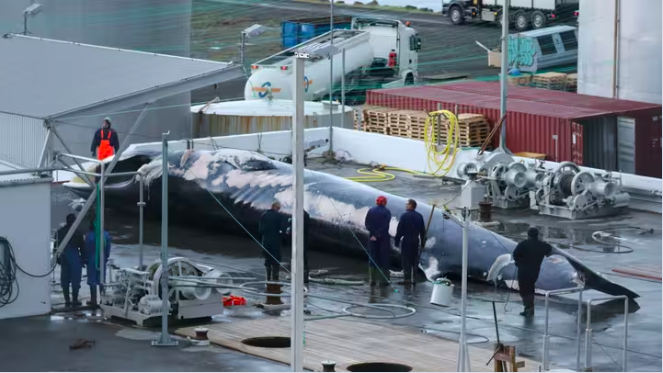The founder of Sea Shepherd was arrested for sailing in Faroese waters as part of the “Bloody Fjords” operation in 2023 against the “massacre” of cetaceans in the archipelago.

A minke whale is caught by a whaler in the port of Kushiro, Hokkaido, Japan, August 22, 2022. (SHINJI HIRAMUKI/AP/SIPA / SIPA)
On one side, the whale hunters. On the other, the whalers. The arrest on Sunday July 21 in Greenland of Canadian activist Paul Watson, founder of the NGO Sea Shepherd and the foundation that bears his name, has put the spotlight on a controversial practice: whaling. In the past, oil from whales fuelled oil lamps, while the meat fed isolated populations in the inhospitable lands of the far north, or the starving inhabitants of war-torn Japan.
The launch in May of a brand-new Japanese vessel dedicated to this hunt, the Kangei Maru, raises the question of the resumption of a practice decried by the general public, increasingly sensitive to animal suffering and the protection of marine ecosystems. And increasingly inclined to support Paul Watson, who is facing extradition to Japan. But what does international law say on the subject?
A moratorium on commercial whaling in place since 1986
To regulate whaling, the International Whaling Commission (IWC) was created in 1946. Faced with populations decimated by fishing, but also by collisions with ships, the organization, which brings together 88 countries, “strives to promote the recovery of depleted whale populations (…)”. From a legal point of view, the IWC relies on the International Convention for the Regulation of Whaling, which regulates three types of whaling: commercial whaling, aboriginal whaling by indigenous communities, notably in Alaska and Siberia, and scientific whaling. Over the years, the IWC has limited the number of species that can be hunted for commercial sale, before effectively introducing a moratorium on commercial whaling in 1986, setting the quota of whales that can be killed for this purpose at zero.
However, Japan, Norway and Iceland continue to engage in commercial whaling. “For the small number of whaling nations that remain, whaling, while today needing to be controlled and sustainable, remains a legitimate activity on a par with other forms of sustainable exploitation of marine resources,” explained British jurist Malgosia Fitzmaurice, Professor of Public Law at Queen Mary University of London, in a 2020 article on the possibility of advancing the regulation of whaling (PDF).
The IWC also recognizes the existence of two sanctuaries (one in the Indian Ocean, the other in the Southern Ocean), but has failed to push through the creation of a sanctuary in the South Atlantic, in the face of opposition from 25 countries, including Japan, Russia, Iceland and Norway.
Japan, against the grain of the international community
Before being arrested in Greenland, Paul Watson was on his foundation’s boat heading for the Northwest Passage, linking the Atlantic and Pacific Oceans. The mission: to intercept the Kangei Maru, a factory ship recently built by Japan in the North Pacific and used by the Kyodo Senpaku company. With its impressive dimensions, this brand-new giant of the seas embodies the country’s whaling ambitions: 113 metres long, 21 metres wide and weighing a total of 9,200 tonnes. The country, the main market for whale meat, left the IWC in 2019, with the intention of resuming commercial whaling close to its coasts. From then on, “within the perimeter of its waters, Japan has absolute authority over the management of living species, including whales”, explained Australian international law professor Donald Rothwell in June, quoted by CNN.

The “Kangei Maru”, a whaling factory ship, in the port of Shimonoseki, Japan, on March 29, 2024. (TOSEI KISANUKI / YOMIURI / AFP)
A member of the International Whaling Commission (IWC) from the outset, Tokyo has long used the fact that the IWC authorizes cetacean hunting for scientific purposes to circumvent the moratorium. Two years after the moratorium came into force, in 1988, Tokyo obtained derogations for “research missions” in Antarctica and the North-East Pacific.
In 2014, the International Court of Justice (ICJ) finally ordered Japan to recall its whalers operating in the Antarctic. The country was violating “the moratoria on commercial whaling and floating factories, as well as the ban on commercial whaling in the Southern Ocean sanctuary”, the ICJ ruled.
In the years that followed, Tokyo continued to argue for exceptions to the IWC moratorium, citing a question of “food safety”. Yet consumption of cetacean meat has plummeted over the years (it now stands at around 2,000 tonnes a year, compared with 200 times that figure in the 1960s).
Iceland and Norway: commercial whaling on the wane
Although both countries are members of the IWC, Iceland and Norway practice commercial whaling. Opposed to the moratorium, Iceland resumed commercial whaling in 2003 for fin whales and Minke whales. Only blue whale hunting, totally banned by the commission, is also prohibited.

Whalers, pictured at a slaughterhouse in Iceland, clean an animal carcass, July 4, 2018. (SEA SHEPHERD/COVER IMAGES/SIPA / SIPA)
In 2020, due to a lack of profitability for this increasingly controversial activity, one of Iceland’s two whaling companies hung up its harpoons for good. And while the remaining whaling company, Hvalur, received a license from the authorities in June to kill 128 fin whales, in recent years Icelandic whalers have rarely managed to meet their quotas. In 2023, 24 fin whales were hunted out of a possible quota of 209. That year, the hunt was halted for two months (out of a three-month season) following a government investigation which revealed that the explosive harpoons used contravened the country’s animal welfare laws.
Over the past two decades, Iceland’s tourism industry – and in particular its giant whale-watching tours – has grown to the point where the need to protect cetaceans appears far more profitable than hunting them.
In Norway, too, whalers are struggling to fill the quotas granted by Oslo, and the number of boats engaged in this activity continues to decline. In 2021, 575 cetaceans were caught – less than half the authorized quota – by the 14 vessels still operating in Norwegian waters.
Source: Franceinfo

